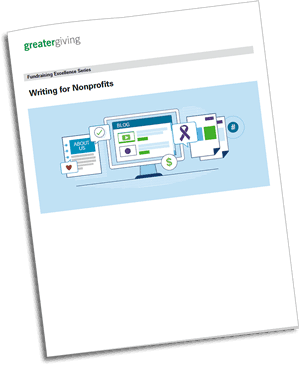

This post is the first in a series designed to teach the art and fundamentals of writing for nonprofits. These posts are based on the “Writing for Nonprofits” Guide from the Greater Giving Fundraising Excellence Series. Each new post focuses on an individual type of communication or relationship, and how best to tailor your writing to it. Read additional articles: Writing For Nonprofits Series
I chose this for our introductory topic because most everything you write for your nonprofit—from capital campaign emails encouraging supporers to donate, to thank you letters after an event—ought to all use a standardized voice. It’s best to establish one up front with specific style guidelines that everyone can use moving forward.
In this post I’ll walk you through developing a voice that represents your brand, increases engagement, and can be tailored for many different purposes.
What is a “voice”?
It’s as literal as it sounds. If your organization were a person, what would it sound like when it talked? Your nonprofit’s “voice” is the embodied personality of your brand.
 A voice is the words you choose to use; it’s your tone, your style, your attitude. Think of it like a brand character: if your organization were a person, what sort of persona would it have? What words would it choose to use? Would it be honest, snarky, intellectual, or straightforward?
A voice is the words you choose to use; it’s your tone, your style, your attitude. Think of it like a brand character: if your organization were a person, what sort of persona would it have? What words would it choose to use? Would it be honest, snarky, intellectual, or straightforward?Establishing a consistent voice for all your communications, from your website to your event invitations, is an important element of your branding. Donors know what to expect when they get emails from you. With the right voice, it can even be something they look forward to.
Developing an organization’s unique voice
The way an organization talks and engages with its audience tells people a lot about that organization’s mission and culture. A distinctive voice allows an audience to build a relationship with that brand, the way you’d build a relationship with a person.
Think about some brand personas you know well, like the Geico lizard. This company has a funny, playful voice, known for its non-sequiturs. A big voice like that can even attract an audience who, of their own accord, can help promote you and your brand. Some brands have found popularity purely through a charismatic or amusing voice.
So how do you set about developing a voice that speaks for itself, and for your organization?
- It helps to build around a character, or the persona your organization would inhabit were it a person (or an animal, or whatever). Start out by brainstorming some adjectives that describe your nonprofit’s character. Playful? Solemn? Witty? Inspiring?
- If your nonprofit were a person, how would they talk and act? Which feelings would resonate most? Decide your organization’s attitude about a wide range of topics, and use that to guide how it converses and engages with people online.
- By extension, carefully choose your language and diction. The individual words you select, and the complexity of your sentence structure, all reflect your personality. Is it simple and easy to read? Is it savvy and clever? Let your intended audience guide your choices.
- Draw from your values and beliefs both to develop your voice, and to engage with your audience while using it. Someone sould be able to infer your organization’s mission from your voice.
 Goals and Tone
Goals and Tone
When developing a voice for your organization, think of it like the overarching style guide. Under those general guidelines you’ll want to further customize each individual communication—whether it’s an email soliciting donations, a funny social media update, or an informative blog post—for that particular channel, and with a tone suited to your audience.
Start with purpose. Establish a goal for each of your communications. Are you intending to entertain? Then funny, pithy, and snarky are good avenues to strike out on. Do you want to court new supporters into getting involved in your new capital campaign? Tailor your voice to welcoming in new members of your community, and introducing them to your organization’s mission in a friendly, inspiring manner.
Tailor for channel. While the goal of your communication will inform a lot about your tone, your channel—an email, a snail mailer, a blog post—should dictate a lot about how you use and narrow your voice. You get more words to work with in an email versus a tweet, so you can expand more on your ideas and let your voice really find its stride. Modify your syntax (sentence structure) and your style to fit your medium.
 Filter with tone. Are you telling a heartfelt story leading up to a call for donations? Filter your usual voice with an honest, authentic tone that will end with a call to action. In a short social media post intended to amplify your reach, stick to your voice style guide but shoot for something concise and witty enough to get shares. Get informal with your volunteer thank-yous, but stick to being polite and personable with your big donors.
Filter with tone. Are you telling a heartfelt story leading up to a call for donations? Filter your usual voice with an honest, authentic tone that will end with a call to action. In a short social media post intended to amplify your reach, stick to your voice style guide but shoot for something concise and witty enough to get shares. Get informal with your volunteer thank-yous, but stick to being polite and personable with your big donors.
And one last tip: always remember who you are! For consistency’s sake, we recommend choosing one individual at your organization to spearhead your communications. You might even consider hiring a professional writer or editor to ensure your more important annual solicitations meet your needs and reach the most people possible.
For more on these topics—such as writing heartfelt stories and compelling calls for donations—be sure to download our Writing for Nonprofits guide! And, read the next article of this series: Major Donors: A Love Story.

